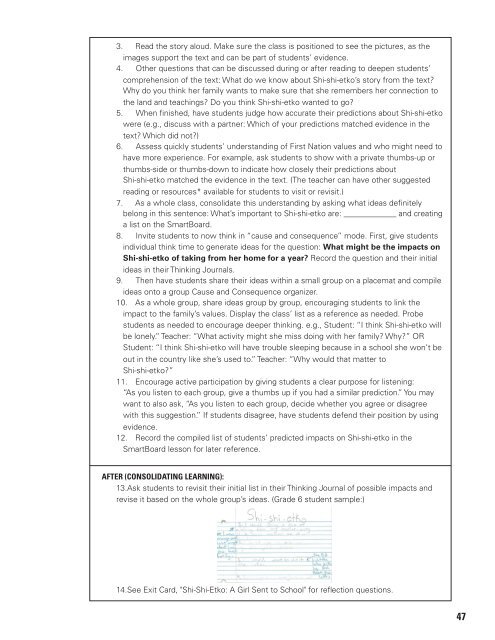Residential Residential
Residential_School
Residential_School
You also want an ePaper? Increase the reach of your titles
YUMPU automatically turns print PDFs into web optimized ePapers that Google loves.
3. Read the story aloud. Make sure the class is positioned to see the pictures, as the<br />
images support the text and can be part of students’ evidence.<br />
4. Other questions that can be discussed during or after reading to deepen students’<br />
comprehension of the text: What do we know about Shi-shi-etko’s story from the text?<br />
Why do you think her family wants to make sure that she remembers her connection to<br />
the land and teachings? Do you think Shi-shi-etko wanted to go?<br />
5. When finished, have students judge how accurate their predictions about Shi-shi-etko<br />
were (e.g., discuss with a partner: Which of your predictions matched evidence in the<br />
text? Which did not?)<br />
6. Assess quickly students’ understanding of First Nation values and who might need to<br />
have more experience. For example, ask students to show with a private thumbs-up or<br />
thumbs-side or thumbs-down to indicate how closely their predictions about<br />
Shi-shi-etko matched the evidence in the text. (The teacher can have other suggested<br />
reading or resources* available for students to visit or revisit.)<br />
7. As a whole class, consolidate this understanding by asking what ideas definitely<br />
belong in this sentence: What’s important to Shi-shi-etko are: _____________ and creating<br />
a list on the SmartBoard.<br />
8. Invite students to now think in “cause and consequence” mode. First, give students<br />
individual think time to generate ideas for the question: What might be the impacts on<br />
Shi-shi-etko of taking from her home for a year? Record the question and their initial<br />
ideas in their Thinking Journals.<br />
9. Then have students share their ideas within a small group on a placemat and compile<br />
ideas onto a group Cause and Consequence organizer.<br />
10. As a whole group, share ideas group by group, encouraging students to link the<br />
impact to the family’s values. Display the class’ list as a reference as needed. Probe<br />
students as needed to encourage deeper thinking. e.g., Student: “I think Shi-shi-etko will<br />
be lonely.” Teacher: “What activity might she miss doing with her family? Why?” OR<br />
Student: “I think Shi-shi-etko will have trouble sleeping because in a school she won’t be<br />
out in the country like she’s used to.” Teacher: “Why would that matter to<br />
Shi-shi-etko?”<br />
11. Encourage active participation by giving students a clear purpose for listening:<br />
“As you listen to each group, give a thumbs up if you had a similar prediction.” You may<br />
want to also ask, “As you listen to each group, decide whether you agree or disagree<br />
with this suggestion.” If students disagree, have students defend their position by using<br />
evidence.<br />
12. Record the compiled list of students’ predicted impacts on Shi-shi-etko in the<br />
SmartBoard lesson for later reference.<br />
AFTER (CONSOLIDATING LEARNING):<br />
13.Ask students to revisit their initial list in their Thinking Journal of possible impacts and<br />
revise it based on the whole group’s ideas. (Grade 6 student sample:)<br />
14.See Exit Card, "Shi-Shi-Etko: A Girl Sent to School" for reflection questions.<br />
47


